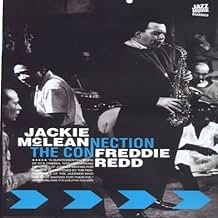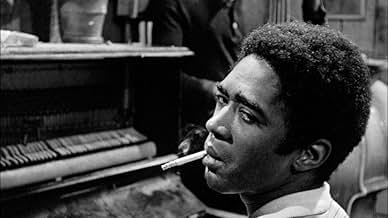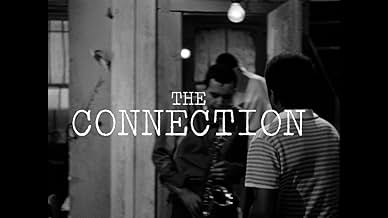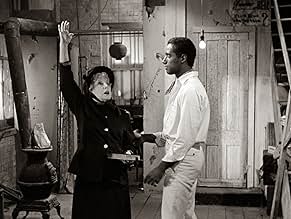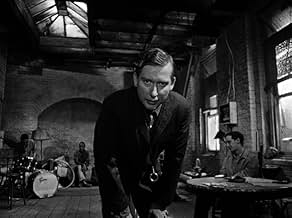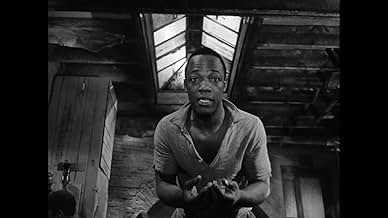CALIFICACIÓN DE IMDb
7.0/10
1.1 k
TU CALIFICACIÓN
Agrega una trama en tu idiomaMen sent their own way await heroin in Leach's apartment.Men sent their own way await heroin in Leach's apartment.Men sent their own way await heroin in Leach's apartment.
Jerome Raphael
- Solly
- (as Jerome Raphel)
Jim Anderson
- Sam
- (as James Anderson)
Roscoe Lee Browne
- J.J. Burden
- (as Roscoe Browne)
Opiniones destacadas
Jack Gelber's play, "The Connection" ran in London not long after its run in New York, with the same cast and same musicians. The film follows the play faithfully: it couldn't really be any other way. I much preferred the play, mainly because of its immediacy and its intimacy as the action unfolds right before your eyes, especially when the 'connection' arrives', and one by one, the players disappear into the bathroom. I don't for one second believe that the actors actually injected themselves, but on stage, the feeling is that they were doing just that. Don't get me wrong, Shirley Clarke's film of Gelber's play is a brilliant testament of how to make a film about a bunch of guys sitting around in one room (most of the time), waiting for their 'connection', without becoming bored or jaded. In fact, the film is on some levels, better than the play. For a start, if you are a fan of jazz and Jackie McLean in particular, you got to see lots close-ups of the band in full flight. Shirley Clarke was/is, one of the many underrated film directors around. If you liked "The Connection" (though 'like' isn't really the correct verb here), her documentary, "Portrait Of Jason" is another gem to seek out.
I don't know why anyone would call this realistic. It looks and feels like a play...the "acting", the overblown dialogue (almost Odets-like), etc. And unless you were a junkie in 1961, how would you know if it's realistic? And Sister Salvation? How could that possibly be real?! Noone is that clueless.
It's obviously dated for many reasons....the "lingo", the lack of serious profanity, the odd discussion of homosexuality.
Still, the film hooks you in...and I'm not exactly sure why. I guess it never really slows down. The camera tricks are cool, the band is great, some good dialogue. And the acting and characters are interesting, if not realistic.
Worth seeing...
It's obviously dated for many reasons....the "lingo", the lack of serious profanity, the odd discussion of homosexuality.
Still, the film hooks you in...and I'm not exactly sure why. I guess it never really slows down. The camera tricks are cool, the band is great, some good dialogue. And the acting and characters are interesting, if not realistic.
Worth seeing...
I'd like to clear up this jazz/heroin confusion (ignorance) that may stop you from watching this great film. Leach is the connection to Cowboy, and Cowboy is the connection to a dealer. The IMDb plot summary says that Cowboy is bringing "the connection" back to Leach's house, but he is really just bringing heroin. The fact that some of the people waiting for heroin are jazz musicians doesn't mean all jazz musicians were addicts, although most of the good ones were. With that said, I would advise any bee-bop fan to watch this film just for the amazing, and sole, footage of Blue Note heavies Jackie McLean and Freddie Redd. You will most likely also like the free-jazz directorial treatment of what was originally a stage play. The film also deserves credit for it's honest portrayal (in 1961!) of heroin addiction, neither glamorizing nor condemning it. The only problem I had was the slightly over-theatrical styles of some of the actors. Overacting did become the Leach character, however: "OHHH, MY BOIL!!!" If you liked "The Incident" or "The Pawnbroker," you'll like this one.
Regular readers of my comments know I study folding, and I suggest that it is a deep concern for many filmmakers going back many decades. Most of my viewing these days comes from reader suggestions.
This is one, and very interesting. Group it with "The Saragossa Manuscript" as an early experiment, probably influential. Crude and obvious, but of historical interest.
I will describe it because it is hard to find.
Ostensibly it is a documentary drama, filmed of then contemporary jazz musicians (man, dig?) in a seedy apartment. They are there for their pooled money to turn into a pooled high, then pooled music. The thing is framed by a device: the film is made by two people, the director and a photographer. During the film, the director has his first hit of heroin, and presumably succumbs to it thereafter. The movie starts with a statement by the photographer that the director has abandoned the project and he (the photographer) has assembled it for us.
In what we call the real world, this is a play about this film-making. So to begin, it is a film about a play (a very obvious play) about a film about a "real" drama. A theory of theater at the time was that such abstraction and acknowledgment of the medium would allow the form of the reality to shine through.
It is the theatrical equivalent of an architectural notion that you can see in the Paris Museum called Pompidou, where all the structure is more than exposed, exposed in a way so obvious it is supposed to be invisible.
You may buy this. I certainly did when I was an architect in this era until I actually designed a building using it.
The difficulties of making this work are enormous.
You can see those problems here. Cowboy is the agent who brings the high. He arrives in pristine white, an articulate black man who used to be a musician and now is a savior. He brings an old woman, a salvation army warrior from 70 years earlier, incidentally 70 years old and worried about her burial.
For this, you need extremely clean images, touchstone dialog (where you jump from pad to pad without muddying yourself), and actors who understand all the folds and can inhabit them all.
This has none of that. These are street performers after the manner of "The Living Theater" which eschewed just the kind of thinking this project demands.
What we end up with is a bunch of actors with empty lives without layers who give us a layered story about a bunch of musicians with empty lives because they left layers behind.
You'll probably want to watch "Hurly Burly" for something like this done well, or this for historical interest.
Ted's Evaluation -- 2 of 3: Has some interesting elements.
This is one, and very interesting. Group it with "The Saragossa Manuscript" as an early experiment, probably influential. Crude and obvious, but of historical interest.
I will describe it because it is hard to find.
Ostensibly it is a documentary drama, filmed of then contemporary jazz musicians (man, dig?) in a seedy apartment. They are there for their pooled money to turn into a pooled high, then pooled music. The thing is framed by a device: the film is made by two people, the director and a photographer. During the film, the director has his first hit of heroin, and presumably succumbs to it thereafter. The movie starts with a statement by the photographer that the director has abandoned the project and he (the photographer) has assembled it for us.
In what we call the real world, this is a play about this film-making. So to begin, it is a film about a play (a very obvious play) about a film about a "real" drama. A theory of theater at the time was that such abstraction and acknowledgment of the medium would allow the form of the reality to shine through.
It is the theatrical equivalent of an architectural notion that you can see in the Paris Museum called Pompidou, where all the structure is more than exposed, exposed in a way so obvious it is supposed to be invisible.
You may buy this. I certainly did when I was an architect in this era until I actually designed a building using it.
The difficulties of making this work are enormous.
You can see those problems here. Cowboy is the agent who brings the high. He arrives in pristine white, an articulate black man who used to be a musician and now is a savior. He brings an old woman, a salvation army warrior from 70 years earlier, incidentally 70 years old and worried about her burial.
For this, you need extremely clean images, touchstone dialog (where you jump from pad to pad without muddying yourself), and actors who understand all the folds and can inhabit them all.
This has none of that. These are street performers after the manner of "The Living Theater" which eschewed just the kind of thinking this project demands.
What we end up with is a bunch of actors with empty lives without layers who give us a layered story about a bunch of musicians with empty lives because they left layers behind.
You'll probably want to watch "Hurly Burly" for something like this done well, or this for historical interest.
Ted's Evaluation -- 2 of 3: Has some interesting elements.
This is a very difficult film, austere and hard, but after about ten minutes you can calibrate yourself to its rhythm, which is slow -- or, not so much slow as not fast, with extremely long takes in a one-room setting. The film, which is about a group of jazz musicians waiting for "the connection" (heroin) in an apartment, is essentially a filmed piece of experimental theater; it's very interesting, I think, and valuable for its honest portrayals of blacks (not all of the characters are black, but those who are are allowed to give equal amounts of monologues to the camera). The film itself, which is a product of the beat culture, is an experiment in subtle documentary satire -- the film is a film that's being made by a documentarian and his camera assistant; the documentarian becomes involved in the "film" himself by interacting with the musicians, trying to get them to act naturally for the camera by saying he's one of them, that he "reads" them. (The film is also a kind of Method film in the sense that the performances are strained and melodramatic -- the main character who owns the apartment has a boil that makes him scream at a few points -- and that everything is about the documentarian retaining emotional truth.) As the documentarian gets involved with the group (and after the connection arrives, with a female religious preacher in toe), the film feels almost like a public service announcement. It's a really fascinating document. 9/10
¿Sabías que…?
- TriviaThis film was held up for release after the Board of Regents of the Motion Picture Division of New York State's Dept. of Education viewed the film and refused to grant it a license to be commercially shown. This was mostly due to the repeated use (seven times) of a four-letter word that rhymes with "hit" and is used as a slang synonym for heroin. The film was judged obscene but opened without a license anyway at the D.W. Griffith Theater on October 3, 1962, only to receive several bad reviews from the major N.Y. film critics. Director Shirley Clarke sued and a month later, the highest court in the state reversed the decision of the Board of Regents. However, the reputation of the film was already damaged and to this day, it has never recouped its original $167,000 budget.
Selecciones populares
Inicia sesión para calificar y agrega a la lista de videos para obtener recomendaciones personalizadas
- Where Can I Find This?
Detalles
- Fecha de lanzamiento
- País de origen
- Sitio oficial
- Idioma
- También se conoce como
- La conexión
- Locaciones de filmación
- Productoras
- Ver más créditos de la compañía en IMDbPro
Taquilla
- Presupuesto
- USD 167,000 (estimado)
- Tiempo de ejecución1 hora 50 minutos
- Color
- Relación de aspecto
- 1.37 : 1
Contribuir a esta página
Sugiere una edición o agrega el contenido que falta

Principales brechas de datos
By what name was The Connection (1961) officially released in India in English?
Responda
